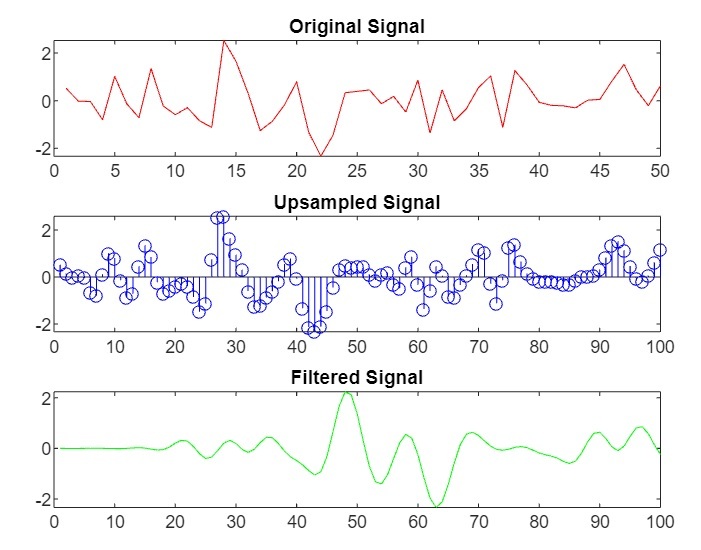
 Data Structure
Data Structure Networking
Networking RDBMS
RDBMS Operating System
Operating System Java
Java MS Excel
MS Excel iOS
iOS HTML
HTML CSS
CSS Android
Android Python
Python C Programming
C Programming C++
C++ C#
C# MongoDB
MongoDB MySQL
MySQL Javascript
Javascript PHP
PHP
- Selected Reading
- UPSC IAS Exams Notes
- Developer's Best Practices
- Questions and Answers
- Effective Resume Writing
- HR Interview Questions
- Computer Glossary
- Who is Who
Filtering After Upsampling in MATLAB Interpolation
In interpolation, filtering after upsampling is an important step to avoid the aliasing and reconstruction of a filtered signal. In MATLAB, there are various built-in functions that can be used to perform filtering after upsampling in interpolation.
Before discussing the process of filtering after upsampling, let us first know about filtering and upsampling in interpolation.
What are Upsampling and Filtering in Interpolation?
In interpolation, upsampling and filtering are two crucial processes used to increase the number of samples in a signal.
Upsampling is a process of adding zeros between the existing samples of the signal. It increases the sample rate or decreases the wavelength of the signal. This process plays a vital role when it is required to match the sampling rate of the signal with the system for processing.
When a signal is upsampled, it adds some unwanted frequencies and creates the gaps by inserting zeros. Hence, to reconstruct the continuous and smoother signal, it is important to remove these unwanted frequencies. This process of removing unwanted frequencies from the signal using a filter is called filtering.
The combined process of upsampling and filtering is known as interpolation.
This is all about upsampling and filtering in interpolation. Let us now discuss how to perform filtering after upsampling in interpolation using MATLAB.
Filtering After Upsampling in Interpolation in MATLAB
In MATLAB, we have two built-in functions named, "interp" and "filter" to perform upsampling and filtering respectively.
Syntax
upsampled_signal = interp(signal, upsample_factor); filtered_signal = filter(Filter, 1, upsampled_signal);
The step-by-step process of filtering after upsampling in MATLAB interpolation is explained below.
Step (1) Load or generate the input signal.
Step (2) Upsample the signal using the "interp" function.
Step (3) Design a filter for filtering of the upsampled signal.
Step (4) Perform filtering of the upsampled signal by applying the filter using the "filter" function.
Step (5) Display the results.
Hence, in MATLAB, filtering after upsampling in interpolation is a straightforward process.
Example
Let us take an example to understand the implementation of these steps in MATLAB programming.
% MATLAB code for filtering after upsampling in interpolation
% Generate a random signal
signal = randn(1, 50);
% Perform upsampling of the signal
upsampled_signal = interp(signal, 2); % Adjust upsampling factor as desired
% Design a low-pass filter
LPF = fir1(40, 0.3);
% Perform filtering of the upsampled signal
filtered_signal = filter(LPF, 1, upsampled_signal);
% Plot the original, upsampled, and filtered signals
subplot(3,1,1);
plot(signal, 'r');
title('Original Signal');
subplot(3,1,2);
stem(upsampled_signal, 'b');
title('Upsampled Signal');
subplot(3,1,3);
plot(filtered_signal, 'g');
title('Filtered Signal');
Output
When you run this code, it will produce the following output

Conclusion
This is all about filtering after upsampling in MATLAB interpolation. In this tutorial, I explained the steps involved in filtering after upsampling in interpolation using MATLAB.
In conclusion, the filtering after upsampling is a crucial step in interpolation as it removes the unwanted frequency components introduced in the original signal during upsampling. It is mainly used to reconstruct a smoother signal after upsampling. The example included in this article demonstrates the practical implementation of steps involved in filtering after upsampling in MATLAB programming.

